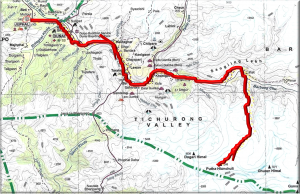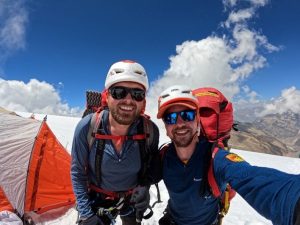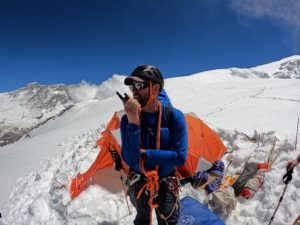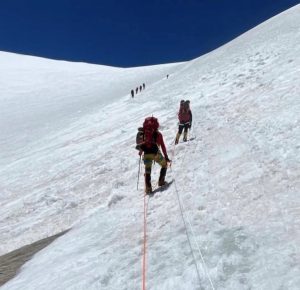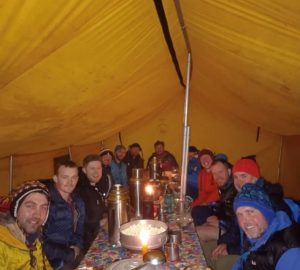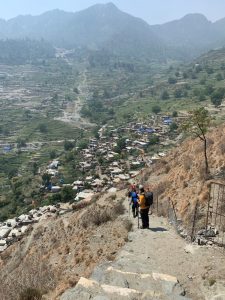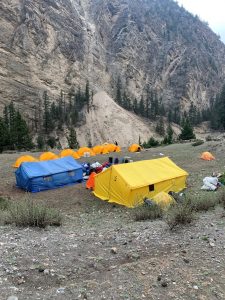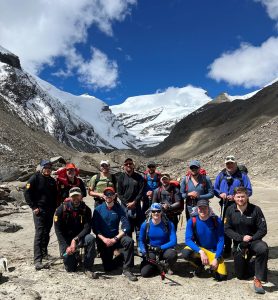The winding path following the Bharbun Khola bent round to the South as we approached Kakkot, in the afternoon sunshine. We were met by 6 women carrying immense loads in Doko Baskets. The usual team chorus of ‘Namaste’ began. They looked quizzically at us. There had been no trekking groups this deep into the Dolpo region for almost 3 years, and we were currently one of only three groups that had been allowed the additional permit required to be here pre monsoon.
The Dolpo region of Nepal is one of the few remaining areas unaffected by commercialised tourism.
Phase One. The Trek.
The team had arrived in Kathmandu 8 days prior, from here we had flown to Pokhara and then onto Juphal; the capital of Dolpo. The plan was to spend 4 days trekking from Juphal to Kakkot along the Bharbun Kola, before a number of acclimatisation days, then crossing a high pass before the final day making our way to Puth Hiunchuli Base Camp, and transitioning to Phase Two of the Expedition.
The hair-raising flight from Pkhara to Juphal gave us our first look at Putha Hiunchuli or Dhaulagiri VII as we skirted below the huge ridge which links all the ‘Dhaulagiris’ Momentary panic swept through the plane as we heard from the cockpit computer ‘Terrain, Terrain Pull Up Pull Up.’ The small ATR-72 plane banked right and then began to land at Juphal.
On landing we cleared the regional immigration; a solitary policeman sat at a desk and a three legged chair, and were met by our Sherpa Team. The Sherpas wasted no time in taking our bags and loading them into Jeeps to be taken to Dunai. the team began its 9km downhill trek to the gardens of the Blue Sheep Inn. There the support team had set up camp in what was to be our first night of 29 under canvas.
Tensing our Sidar negotiated with the local pony men who were going to begin transporting the 3500kg of kit, equipment and food the team had with it. Once the usual bartering and weighing of loads had taken place, the Gauntlet Rise team set off towards Tarakot. We walked through downtown Dunai and crossed the river and as we did so the valley widened, and we got our first view of snow capped mountains. Looking down the juniper forest flanked valley the scale of what we were embarking on suddenly dawned on me. I was here in the Himalayas, leading an expedition. Two years of planning and training had led to this moment. There was nothing else left to do but now live each day as it came and concentrate on the task at hand.
The task that day was a stomach bug which had gripped three members of the team. With afternoon temperatures of 30 degrees Celsius all were glad as we came into the small trading hamlet of Tarrakot, despite the campsite being on a 5-degree slope!
Our team made up of 12 Soldiers and Officers from across the British Army’s, Royal Armoured Corps, their basecamp manager (an ex-Warrant Officer from the Royal Armoured Corps) and their support team, struck camp and headed off before the sun had chance to warm the valley temperatures to the uncomfortable levels of the previous two days.
Musi Kola was 12km further up the Thuli Bheri valley. It became very apparent that the local population were not accustomed to seeing trekkers. Lots stopped to speak to us through the translation of one of our Sherpas Tsering. Tsering is one of very few female Sherpas, she is currently going through her guiding qualifications and is well on her way to leading trips for herself.
The campsite at Musi Kola was incredibly comfortable compared to the previous night, a small meadow a top a 50m cliff and the river below.
The weather finally broke in the evening as it had been threatening all day and we had a night of rain.
The next day we headed to Kakkot. Where we would base ourselves for a number of acclimatisation and rest days before making our move to base camp over a high pass (4,100m).
On arrival in Kakkot it turned out that we would be sleeping in the playground of the local school as the children were on school holidays. The team were in for a treat as the team cook had been able to buy eggs in one of the shops in town… Pancakes. LCpl Oliver impressed all on the team with his eating ability consuming 9 pancakes in addition to his lunch!
Overnight our chief instructor took a turn for the worse, what we had suspected to have been a case of food poisoning started to develop into something more sinister. The Expedition Leader Capt Turner utilised the team’s Satellite Phone to call back to the expeditions 24hr Medical Cover.
The news wasn’t looking good. The Doctor had made the assessment that it was likely to be a Urinary Tract Infection caused by dirty water, and the antibiotic treatment was essential if Glenn were to remain with the expedition.
Capt Turner set about the local area looking for anyone who was a doctor or a pharmacist, just as he was beginning to lose hope, once again (and not for the last time) our Sidar came to the rescue providing a full course of the antibiotics required.
Despite the medical issues ongoing there was still the need to acclimatise and train. The next day the team headed up to recontire the route that we would take in the following days to reach Base Camp. Once at 4000m a new heigh point for almost 50% of the team we sat down to eat lunch before returning to the school playground.
The third day in Kakkot, active rest was the order of the day. The instructors rigged up fixed lines, with direction changes and even a short abseil to finish. We practiced tying into our harness with our expedition mitts on, erected and collapsed our mountain tents and just before lunch made cups of tea using the stoves we would have at the high camps.
In the afternoon Sgt Sudlow demonstrated just how many times one can pack and unpack a bag, carrying out a huge number of kit checks until his bag was exactly as he wanted it.
The next morning we realised that if we thought donkey men bartering was wild, haggling for yaks was on a whole other level. After nearly 3 hours the Yaks were loaded and the team left the last people outside of the team that they would see for nearly two weeks.
The team knew that from now on the trip was only getting more serious. While remaining jovial and jokey there was certainly an appreciation that from here on in the days were going to be far harder.
We began climbing from Kakkot, up scrubland, DIY ladders and bridges and up onto a narrow ridge. We crossed our high pass at 4,650m and descended into Pangi Camp.
We woke at Pangi Camp to hear the cries of the Yak herders calling to their Yaks who had spread out over the mountainside during the night (they don’t tether them).
Opening up the tent showed a fair bit of snow had fallen over night, unsurprising at this height (4500m).
After a few concerns about ground conditions we set off on the long haul to Base Camp and it was noticeable immediately the effect of the altitude, even simple tasks produced heavier breathing as we coped with the 50% reduction in oxygen.
The ‘path’ to BC now became very broken as we approached a high alpine yak pasture called Yak Kharka, which had a few huts to shelter the herders.
The ground now was very broken with ravines to cross and a short scramble across a spur…all the time, the yaks just carried on their easy pace (with 60kg on their backs).
The porters, cook boys and Sherpas had forged on ahead to start setting up BC and it was a very welcome sight after 7 hours of slow trekking uphill (and down…and across).
Our home for the next two weeks was spectacularly set at the base of the Ghandeu Glacier at a height of 4950m.
Phase Two. The Mountain.
A frosty start to our 2nd day at Base Camp and an important one…the Puja!
A very interesting ceremony led by Dorje, where our mountaineering kit was blessed and we have prayers for our safety on the mountain…finished off with a spoonful of Nepalese rum.
After the ceremony concluded we hefted our bags for our first load carry to Camp 1 and set off (very slowly) into the mist and followed the Ghandeu Glacier to approx 5200m where we stashed the 35kg loads before a short break and heading back down to BC.
An absolute stunner of a morning finally revealed the mountain to us…towering 2km above us at Base Camp.
With the weather so good, the team where all in great spirits as we did our second load carry to Camp 1. It was amazing what good weather and being able to see the mountain did for the team morale, the day before felt like back breaking work but today everyone was optimistic even with a second load.
After the optimism of reaching Camp 1 and completing all of our load carries in great weather, we are dealt a huge blow in losing one of our rope leaders, Gaz. Severe D&V overnight complicated by the altitude meant we had been advised by our medical support in the U.K. that we needed to evacuate him to a hospital. However due to our very remote location and the fact that the nearest airstrip was 5 days trek away meant the only option was to get a helicopter into BC to extract him.
Absolutely heartbreaking to lose a team mate, not too mention a personal friend but sadly this is part and parcel of high altitude mountaineering in remote locations, ultimately Gaz’s health trumped all other considerations.
Today we said goodbye too two team mates, Gaz through ill health and Matt who would be accompanying Gaz back to Kathmandu and hospital. An incredibly emotional farewell that brought huge lumps to everyone’s throats. After monitoring Gaz through the day and night who to monitor his stats. During the night Gaz felt well enough to come off oxygen and finally managed to get some reasonable sleep.
After waving goodbye to the guys, our minds turned to the job in hand as we finally left the ‘relative’ comforts of Base Camp and headed to Camp 1 with all of our sleeping and mountaineering kit, big loads once again but we knew this was the start of actually getting onto the mountain itself.
A day of conflicting emotions, sadness and excitement…a weird mix.
Load carrying from Camp 1 (5250m) to Camp 2 (6150m) proved a hard day on the hill, as before we started we lost another member of the team to an upset stomach, but at least this time it was only temporary.
After donning our High Altitude boots we made slow progress across the last of the moraines to the start of the snow ramp. However the ramp we were planning to follow held a surprise for us! After a section of good snow to access the ramp, it turned out to be completely clear of snow, which, if we had been in approach shoes, would have made for an easy ascent. However the heavy, triple layered HA boots (each weighing c.1kg) proved to be as effective as walking in diving boots.
As we got higher, the team struggled with the weight, the boots and the altitude. At approx 5850m and with the steep fixed lines ahead of us, our chief instructor called a halt to the days effort, fearing that the team might empty the tank before we even got to the higher slopes. We stashed out loads and made a slow descent back to Camp 1.
The next morning and after the physicality of the previous days load carrying to 5850m, we make the decision to have a rest day. This will allow the team to sort their bags for the big pull up to Camp 2, take in as much hydration as possible (as demonstrated by our remarkable tea guru, Roy), eat and enjoy the sun. Not forgetting the all important beard trimming with medical scissors.
A small group descend back to Base Camp to collect some bits and pieces that people have forgot and take advantage of some excellent noodles rustled up on the spot by Chef. Without full loads the walk down and back is ‘pleasant’…a rarity over the last couple of weeks.
However everyone’s thoughts are on tomorrow, the full climb to Camp 2 and the first time on fixed ropes for the majority of team. 6000m is a big number and I can tell it’s on peoples minds.
The ‘big’ move to Camp 2 began with an early start allowed us to cross the frozen moraines and the first snow apron in good time before starting the grind of Red Flag Hill and then the access ramp to the fixed ropes at 5900m.
Unfortunately one of team, who had been suffering from an upset stomach for a few days, started to move very slowly and struggled with the very heavy loads we were carrying. With the bulk of the days climbing above us, it was decided amongst the Expedition leadership team that the team member should descend back to Camp 1. Very sad that we would lose another team member but ultimately the right decision for both the individual and the team. Now we were 9.
The Chief Instructor Glenn drew the short straw, he dropped his pack at the top of Red Flag Hill and escorted the team member back down to the snow apron, across it and back onto the ‘safe’ moraines, where Roy (ascending from Camp 1) met him and escorted him to Camp 1. Sad to say farewell as I turned back uphill to try and catch the team up before the fixed lines.
Amazingly Sherpas Dorje and Smiler had taken turns in carrying Glenn’s rucksack up to the fixed lines, literally a weight off his shoulders that allowed him to ascend quickly.
At the top of the ramp we put out all of our metal work on, clipped onto the fixed lines and started the steep pull up and across the snow shoulder and into Camp 2 at 6100m.
By this time the sun was well on us and the snow had started to soften, making the going very hot and hard.
We finally pulled into Camp 2 in the early afternoon and set about getting as much fluids and food into us as we could. As we did the team took great delight that at somepoint during the day the Exped Leaders suncream had exploded in his rucksack, covering a great deal of his kit in factor 50!
After a very clear but cold night, the team; now split into two Rope Teams, ascended up towards Camp 3 (6500m) as part of our acclimatisation profile and to load carry our final set of rations in preparation for summit day.
Rope Team One set ofg first in pretty much perfect conditions, firm snow underfoot, clear skies and not a breath of wind. They quickly (but breathlessly) made it to 6300m and the start of the next set of fixed lines. At the base was a tent that the Sherpas had put in the day before. After a little confused chatter (language barriers) it became apparent that the Sherpas didn’t feel that Camp 3 was in the right location due to avalanche fears. It later transpired that the intended site of Camp 3, whilst on good snow, was actually on a huge sheet of blue ice. Ultimately, we pay the Sherpas for their advice and support, so it would be foolhardy in the extreme to ignore their wealth of knowledge.
We decided however that whilst everyone was feeling ok (this is relative after three weeks of tent life and over 6km above sea level) and conditions were ideal, that we would push on to cross the 6500m threshold. In order for the entirety Chief instructor included to achieve a new personal high.
Feeling very pleased with ourselves we started to descend and as we did, clouds started rolling in ominously from the south.
Rest Day and bad weather.
A rest day isn’t really a rest day above 6000m…we were pretty much confined to our tents by high winds and continual snow.
The day was spent, packing, repacking, hydrating, eating, listening to audio books and occasionally ‘visiting’ the neighbours for a change of scenery.
Overnight the snow stopped, the wind was still blowing cold and hard but now was the time to put all the negative thoughts to one side and focus on getting the team to the summit.
The Expedition Leader had complained earlier in the morning of feeling unwell but after being checked over and discussing it with the Instructors, he felt ok to carry on.
We set off but fairly quickly Capt Turner looked to be struggling. After another check on him and a short rest we moved again.
Then things went wrong… Capt Turner took another 10 steps, swayed and collapsed.
Nathan wasn’t coherent and was struggling to control his breathing. The Sherpas had emergency oxygen which we gave to Nathan and after 5 minutes (which felt like a lot longer) Nathan’s breathing started to stabilise and he was able to communicate.
All thoughts of the summit were dismissed and instead we now had a very real and serious situation with a casualty who appeared to suffering from severe altitude sickness. Our initial diagnosis was High Altitude Pulmonary Edema (HAPE), a life threatening condition that could kill Nathan unless we descended quickly.
Mal the leader of Rope Team Two took the remainder of Team One, and his, back to Camp 2 and prepare a tent for Nathan. Glenn and the Sherpas then carefully descended with Nathan back to the security of Camp 2, thankfully whilst slow going it was without mishap.
By getting back to the tents at Camp 2, Glenn took stock, re-examined Nathan.
After talking through the symptoms with both Mal and Roy (over the radio at Camp 1) they quickly came to the conclusion that Nathan was actually suffering from High Altitude Cerebral Edema; a very serious condition that can kill a suffer within 12 hours.
We knew that descending as quickly and as far as we could would give Nathan the best chance of survival. Being lower would also make helicopter rescue more viable if we needed it.
The plan was to keep Nathan on oxygen for an hour whilst we sorted the rest of the team out and then when (if) Nathan could move, Glenn would short rope him down to fixed ropes, and then down to Camp 1, nearly a kilometre below us. The rest of the team would descend ahead under the supervision of Mal. This did mean that we would need to take all of our gear in one hit, a huge load. Each part to the plan had a Sherpa to support with the rest stripping the mountain as we retreated.
With Nathan now recovered enough to move, it was time to act.
Moving slowly and carefully we inched our way down, descending a mountain, with a HACE sufferer on fixed ropes, carrying huge loads was certainly not something anyone on the team had done before. Especially as the snow had now softened alarming, but we made it to Purgatory Point, the top of the across rock access ridge after a couple of hours. From there it took the team a further 9 hours, but we made it, safe, and relatively unscathed the team set about eating and drinking as much as they could.

